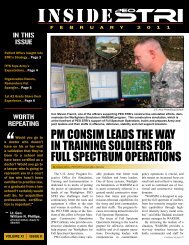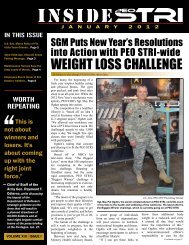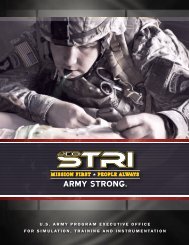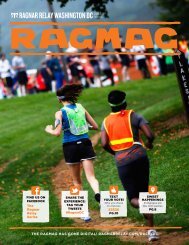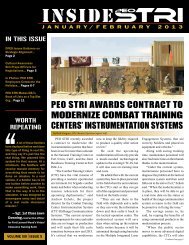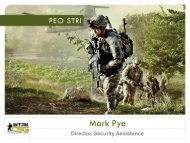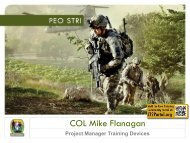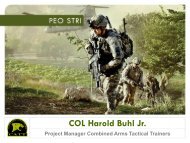TILO: Capability Areas of Interest - PEO STRI
TILO: Capability Areas of Interest - PEO STRI
TILO: Capability Areas of Interest - PEO STRI
You also want an ePaper? Increase the reach of your titles
YUMPU automatically turns print PDFs into web optimized ePapers that Google loves.
<strong>Capability</strong> <strong>Areas</strong> <strong>of</strong> <strong>Interest</strong><br />
Tr a i n i n g P r o d u c t s a n d S e r v i c e s – Vi r t u a l<br />
• High Fidelity Immersive Training Environment:<br />
Believable, well-developed and economically feasible “interactive” computer-generated virtual humans and targets. Trainee<br />
interacts with, controls and commands virtual humans and targets in the ITE using natural language, motions and gestures.<br />
Realistic & cost effective locomotion <strong>of</strong> the trainee in the ITE. Effective implementation <strong>of</strong> VR/AR/MR technologies. Increase<br />
cognitive and emotional stressors.<br />
• Virtualization Technologies:<br />
Delivery <strong>of</strong> "distributed" training and simulation services from centrally located simulation/processing hubs to provide better<br />
utilization and efficiency, and simplified support and maintenance. Effective implementation <strong>of</strong> Cloud computing, virtualization<br />
and SOA concepts/technologies.<br />
• Synthetic Natural Environment Enhancements:<br />
Support air and ground mission rehearsal systems with rapid updates to existing terrain databases. Allow trainee to interact with<br />
physics-based models and receive appropriate feedback in the synthetic environment associated with route clearance/IED<br />
defeat and construction equipment training systems. Manipulate<strong>of</strong> physics-based virtual objects in a virtual environment.<br />
Common, robust weather and atmospheric simulation for real-time training systems in a DIS environment. Realistic life form<br />
representation in virtual simulations. Modeling and behaviors <strong>of</strong> soil/water characteristics.<br />
• Virtual Environment:<br />
Modeling <strong>of</strong> Obscurants/Illumination: Improve modeling <strong>of</strong> obscurants and illumination that impact sensors-behaviors and target<br />
engagement. Moving models with realistic thermal signatures.<br />
• Interoperability:<br />
Interoperability between virtual simulations, between virtual and constructive simulations, between virtual and live simulations.<br />
Common correlated terrains, fair fight engagements, SAF behaviors, etc.<br />
• High Fidelity Medical Simulation:<br />
Medical simulations whose interaction with the virtual world more realistically portrays the level <strong>of</strong> fidelity necessary to readily<br />
transfer the learning experience to actual patients; high fidelity medical simulations should match the vagaries <strong>of</strong> the<br />
individualistic nature <strong>of</strong> the human body and be easily User re-programmable to capture multiple nuances <strong>of</strong> a similar condition.<br />
High fidelity medical simulations to support combat medic, surgical support and ER team training.<br />
• Sensor Technologies:<br />
Sensor technologies to support immersive training environment: head tracking, eye tracking, weapons orientation, haptics,<br />
motion tracking, etc.<br />
• Modeling and Behaviors<br />
Provide physics-based modeling <strong>of</strong> ammunition effects and environmental damage. Provide realistic behaviors for virtual 3<br />
humans and crowds.



